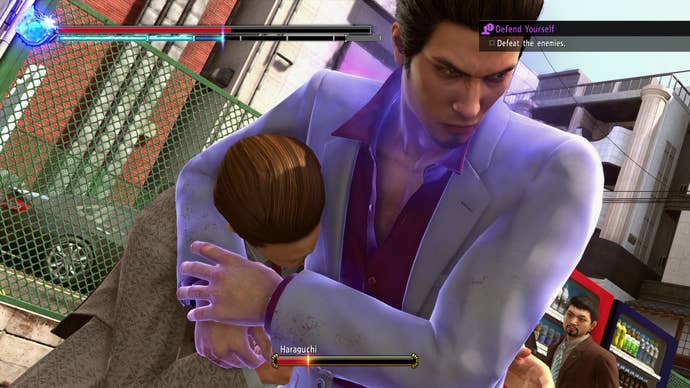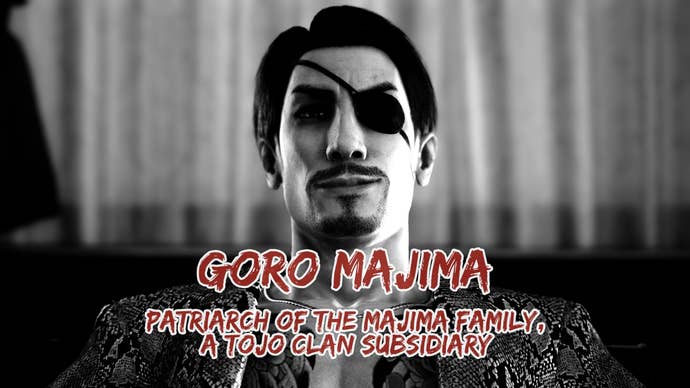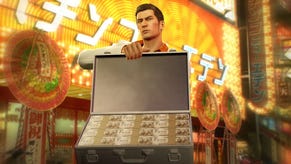Yakuza Kiwami 2's Kamurocho Excels in a Familiar Yet Expertly Overhauled Experience
Big town showdown.
This article first appeared on USgamer, a partner publication of VG247. Some content, such as this article, has been migrated to VG247 for posterity after USgamer's closure - but it has not been edited or further vetted by the VG247 team.
Yakuza Kiwami 2 opens on a dark note. It’s the early 1980s in Kamurocho, well before the events of Yakuza 0. This isn’t a particularly welcoming place, as we came to know in the aforementioned game, and it’s mere seconds before gunshots ring out. We see Shintaro Kazama as a (somewhat) younger man, gunning down an unknown Chinese mafia member in cold blood. It’s an equally cold opening, that’s for sure.
As Kazama vanishes, the entire scene is witnessed by an unknown character—a detective, thought it's hard to believe detectives even existed in the lawlessness of 1980’s Kamurocho. Nursing the unknown victim of Kazama in his arms, he loosely agrees to keep the victim’s wife and child safe, before racing up the stairs and rescuing both from the blaze of a sudden inferno.

We’re truly plunged into the nightlife setting of pre-Yakuza 0 in this opening sequence. We rush from partygoers lining the streets and thumping music echoing throughout the city of Kamurocho in the 1980’s, straight to 20 years into the future in 2006, where the same grizzled detective bemoans his past deeds of that night. There are more questions than answers in this sequence, but Yakuza has always excelled at setting up mysteries to be teased, and then solved at the last minute.
We’re then taken to a more familiar setting—Kazuma Kiryu and Haruka Sawamura, living a peaceful life together, far removed from the urban chaos of Yakuza Kiwami. It’s been a year since the events of Yakuza Kiwami, and it’s clear that both this sequel, and it’s protagonist, are struggling to move on. The pair kneel together to offer their prayers to three shrines: that of Akira Nishikiyama, Shintaro Kazama, and Yumi Sawamura. “I don’t know why I’m still here,” mutters Kiryu, which draws an understandably startled look from Haruka. This is her father figure, after all.

Yakuza has never been the most subtle franchise, and it’s clear that it’s the franchise itself, not just the characters we see before us, that are paying their respects to the fallen before moving on. Because moving on is exactly what Yakuza Kiwami 2 does after Kiryu and Haruka have had merely a moment's remembrance, as the fifth Tojo Clan chairman to take the reins after Kiryu’s retirement is gunned down in front of the pair, forcing them both into another reckless adventure with rival Yakuza. While working to find out who wants him dead and why, Kazuma Kiryu has a target on his back as usual, sort of like one of the characters in The Wire knowing that Omar is looking for them—they don’t really know why, but nothing good will come of it.
From here we hit the streets of Kamurocho again, for what feels like the millionth time in recent memory. But coming back to the same city always feels new and different in some way—maybe there’s an internet cafe where a bar used to be, or there’s now a gym where a ramen joint once was. Yakuza 6 marked the big switch to the more powerful Dragon Engine earlier this year, and it changed up Kamurocho in massive ways, making the city feel more fluid and vibrant, without ever making it feel overbearing. The same goes for Kamurocho in Yakuza Kiwami 2: the city feels more lifelike and densely populated with real thugs and shops.

Speaking of thugs, this wouldn't be a Yakuza game without streets of thugs to beat to a pulp, would it? Combat in Kiwami 2 largely follows the same patterns established in Yakuza 6, utilizing the Dragon Engine to vanquish loading screens in between battles, creating a more seamless modern open-world experience. You can now pick up weapons (read: traffic cones and shop signs), and store them away in your inventory for future use. It’s a nice twist on the disposable weapons system from previous Yakuza games, and this time even your enemies can pick up and occasionally use weapons around the environment, as I found out when a traffic cone collided with the back of Kiryu’s head.
Kamurocho might be a slightly more civilised place than it was back in the speedball disco setting of 1980’s Yakuza, but it hasn’t lost any of the fun. Yes, the discos are long gone, but the karaoke, golf, and other mini activities are still very much there. The karaoke is still the pick of the bunch for me, as Kiryu acts out music videos encompassing his feelings for the fallen Nishkiyama, as well as other compatriots he’s lost along the way, all in a frantic but fair rhythm game.

Fundamentally, this is still the same Yakuza that we’ve come to love. Sega has done what it did for Yakuza Kiwami—take the base story of the original game, and spice it up with an inviting environment and brilliant combat—now for Yakuza Kiwami 2. Adjustments are even being made to the original story to include playable sections as the fan-favorite Goro Majima, after his absence was felt during Yakuza 6 earlier this year (although I didn’t see him during my time with the opening hours of the game). There’s a lot that Sega is changing and improving upon for this remake, while retaining the core story and characters that made Yakuza 2 great.
If you—like me—have loved revisiting the history of Yakuza in a post-Yakuza 6 world, then you’re in for a treat with Yakuza Kiwami 2. Simply put, it’s the city of Kamurocho that has always entertained us, partnered with our leading man Kiryu Kazuma that we’ve always loved, all in glorious detail with the Dragon Engine.








